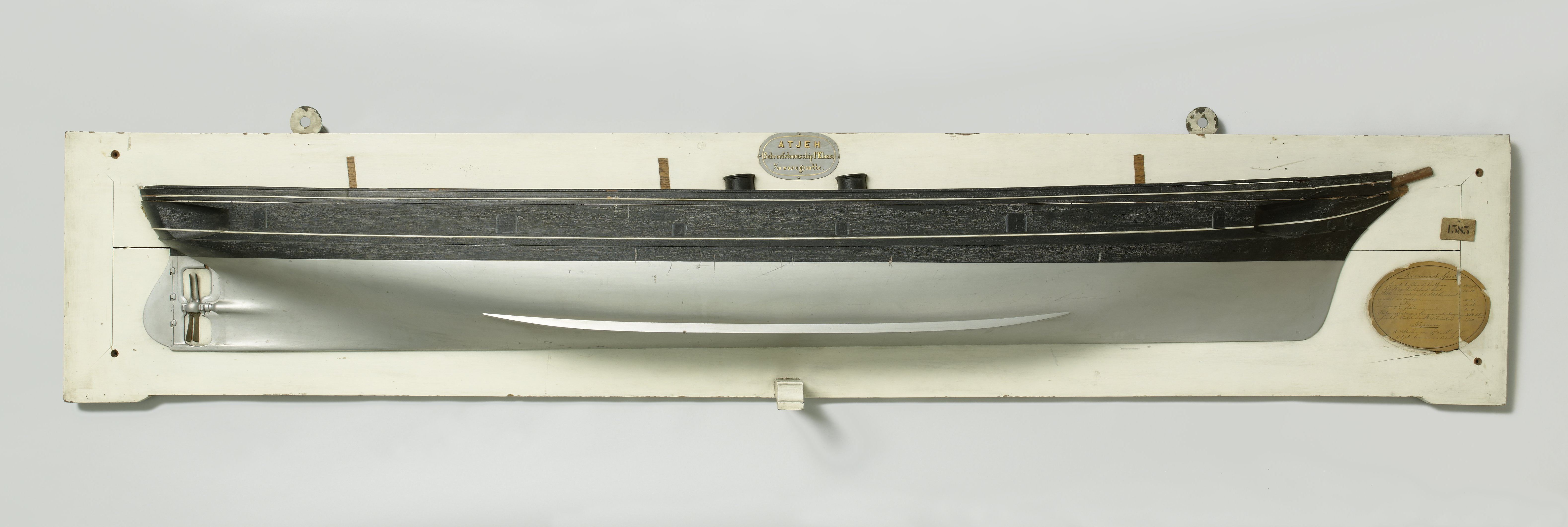Model Hr. Ms. Atjeh Rijksmuusem Amsterdam . Original source model
At Bahia was fresh meat, bread and soup vegetables bought. While the victuals on board at the departure were for just 16 weeks decided her commanding officer to buy 7 ox (each 203.000 reis) and 450 kilo hay (300 reis/kilo). Further more was 434 ton coal (38 shillings/ton) and 114,5 tons drinking water (6.000 reis/1.000 litres) bunkered. The Dutch consul at Bahia who was at the same time also consul of Norway asked the commanding officer for assistance with the diving gear and some divers to find and stop a leak in the Norwegian merchant bark Tristad master N.E. Gabrielsen. This was done with success. At Bahia was none diving gear available and the bark was too large for the existing slipway.
Notes
1. Laid down at the navy yard at Amsterdam, Netherlands on 3 March 1875, launched on 6 December 1876, commissioned on 1 November 1877, converted into a an accommodation ship at the shipyard De Lastdrager at Den Helder, Netherlands in 1906. Commissioned while replacing the Het Loo in 1908, also used as floating battery for salutes by replacing the 12cm by 7,5cm guns since 1910, further more used for training sailors of the Royal Naval Reserve at Willemsoord, Netherlands until 21 May 1921, decommissioned and since then used as accommodation ship for the air service at Willemsoord, Netherlands, disarmed until 1922, disarmed and stricken in 1929 and finally sold to the N.V. Frank Rijsdijk‘s industrieële onderneming at Hendrik Ido Ambacht, Netherlands for ƒ 23.501,00 to be broken up in May 1935. With a displacement of 3.160 ton were her dimensions 80,00-91,85 (over all) x 12,50 x 6,10 metres. The horizontal direct working single expansion steam engine of the Koninklijke Fabriek van Werktuigen at Amsterdam, Netherlands and 4 boilers supplied a horsepower of 2.750 hp was her speed 14,25 miles. She was iron-and wood planked. The original armament consisted of 6-17cm guns and 4-12cm guns. In 1864 were 4-12cm guns and 4-3,7cm revolver guns added. Frigate rigged. When purely sailing could her telescopic funnel be lowered and the large double bladed screw be lifted.
2. Launched at the Arsenal de Marinha do Rio de Janeiro, Brazil on 7 May 1782, commissioned on 22 August 1872 and on 28 April 1896 decommissioned?
3. A wood-built unprotected cruiser, laid down at Cherbourg, France in 1880, launched in 1884, completed in September 1886 and stricken in 1899. With a displacement of 3.700 tons and as dimensions 77,26 x 14,02 x 6,60 metres and an armament of 4-16,25cm/6.4” guns, 12-13,86cm/5.5” guns, 1-3pd revolver, 10-1 pd revolvers and 2-35,56cm/14” torpedo tubes.
4. Albert Pougin De La Maisonneuve (22 January 1839 Montargis, Loire-9 May 1903, Paris, France), since 24 July 1895 commanding the Division navale de l’Océan Atlantique.
5. Launched by bath Iron Works, Maine, USA on 11 May 1892, commissioned on 22 October 1894 and for the last time decommissioned on 28 August 1919, sold on 5 August 1921 and sunk due to an internal explosion on 12 December 1924 while underway towards Texas, USA to be broken up.
Source
Jaarboek van de Koninklijke Nederlandsche Zeemacht 1895-1896.


